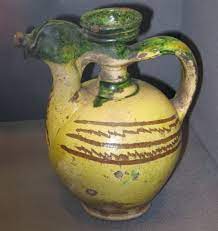The preparation for the ritual starts on Easter. A virgin girl from the family of the deceased person is tasked with going every morning to the well and fetching water in two jugs, like this one...
These jugs with water are brought home blessed and dedicated to the the deceased with the words "This water is for the deceased...so and so". The jugs are then placed outside of the house next to the house door...
On the day of Pentecost, a special "white" feast (only white food and drink are served) is prepared for the family and friends of the deceased, who come to witness the ritual...
Ritual begins before sunrise. Three women light a candle each. Then, after they bow towards the rising sun, they kneel, kiss the ground, and exclaim this prayer: I pray that the deceased, so and so, is let into the light (sunny) place...
Then the three women drink the water from three glasses and eat some of the white food laid on three plates...The feast then starts and lasts until the sunset...
When the sun sets, the virgin girl that gathered the water from the well, brings some water to all the other houses in the village. The last jug is brought back to the well from which the water is taken and is poured back into the well...
This is really cool on so many levels.
First I love the fact that the women pray to the sun to let the deceased "into the light place"...Does this mean "let him return, be reborn"? Is this sunny, bright place, our world, the world of living?
Second, why is all that water gathered for the deceased? Well, did you know that in Serbia people believed that droughts could be caused by the angry thirsty ancestors who didn't receive their water libations? I talked about this in my post "Thirst"....
In Serbia, for 40 days after the burial, the family of the deceased used to take water from their well to 40 different houses, different house each day, "for the soul"...
In Stip, Macedonia there is a curse "May no one bring water for him for the other world"...Some curse...
This belief that "the otherworld was a thirsty place" was widespread and ancient. And was probably the reason why we find "empty" vessels in graves since Neolithic...Were they actually placed into the graves full of water (for the road) which evaporated? I talked about this in my post "One for the road"...
Another interesting thing about this ritual is that all the food and drink had to be white? Why? Is it because white was the color of death? Or because white was the color of light? Not sure what to think here...
Finally the whole water gathering ritual is seriously cool. The water is gathered by "a virgin girl". A girl who had her first period. Whose "water of life has started to flow". Who is full of "life force". But who has not used any of this life force for producing new life yet...
Water is gathered from a spring. Spring water is in Serbia called "živa voda" (live water, water of life) and is believed to have magical properties. It is believed that it can even bring the dead back to life...
The spring water is the menstrual blood of the mother earth...And it is literally "water of life". The water for the ritual is collected during spring time...From virgin Mother Earth...Full of life force, which she still hasn't used this producing new life (crops) yet...
This link between virgin girls, virgin spring earth, water, life and rebirth is what I talked about in my post "Willow in Slavic folklore"
So where's willow here? Well, willow was in the Balkans often planted on graveyards...I didn't understand why, until now...Willow, water, always thirsty dead??? Did people believe that willows attract water? I know they used willow branches for finding water...
In return for regular mention, food and drink...I talked about this in my posts "Diduch", "Thirst", "Blood red wine", "Wolf feast", "Tombstones"...
Sources (Serbian)
Vlah custom description: "Namenjivanje za dušu (daće, pomane)" (Offerings "for the soul") - Mira Stevanović
Willow in the cult of the dead: "Rečnik srpskih narodnih verovanja o biljkama" (Dictionary of Serbian folk beliefs about plants) - Veselin Čajkanović









For death, white food & water; for birth, dark food & milk (or blood?)?
ReplyDelete"This belief that "the otherworld was a thirsty place" was widespread and ancient."
ReplyDeleteVery likely because of evaporation as you touched on, same with blood and wine. It must've seemed mysterious how a pool of blood or water just magically disappears over time like some spirit drank it.